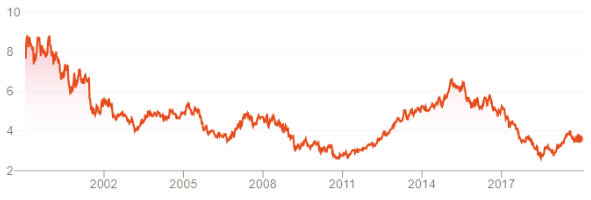

Predicting what the share market index will do this year is a losing game. Instead, focus on bottom-up analysis: identify quality companies and buy them when they trade below fair value.
From an asset-allocation perspective, I’m reasonably comfortable with equities in 2020. Shares remain relatively cheap against bond yields and global growth should improve a little next year. So too Australian economic growth, as another two expected rate cuts next year spur demand.
Geopolitical, trade and political risks, notably around US President Trump, remain. But it felt like there were bigger threats for global share markets this time a year ago.
Still, I can’t see the S&P ASX 200 index delivering another total return (including dividends) above 20% as it did this year. A likelier outcome is a low double-digit return. However, forecasting market indices, as I said, is guessing.
My top three large-cap stock selections for 2020 are: Telstra Corporation, ANZ Bank and Woodside Petroleum. More on them shortly. I’ll nominate my three top mid-, small- and micro-cap stock ideas for 2020 – and a few sell ideas – in coming columns for The Switzer Report.
First, a recap of my top ideas for 2019. After all, what is the point in commentators suggesting positive or negative stocks ideas if there is no accountability? The blur of “top stocks for the year ahead” stories adds to market noise if they are never followed up.
I nominated Coles Group, Auckland International Airport and British bank CYBG (now Virgin Money UK Plc) as top buy ideas for 2019. Their total return (including dividends over one year was 37%, 31% and 6% respectively, Morningstar data shows. CYBG’s performance was complicated by its Virgin Money merger.
Here are this year’s 3 ideas:
1. Telstra Corporation (TLS)
The leading telco has rallied from a 52-week low of $2.71 to $3.73 as the market reappraises its prospects. Telstra has much ground to make up: over three and five years, the annualised total return is slightly negative. The 10-year annualised return is only 8%.
The market’s bearish view on Telstra was based on two key factors: intense competition in all telecom segments, and the billion-dollar hole in its earnings left by FY22 once the National Broadband Network (NBN) is fully rolled out. Rising regulatory risk is another threat.
However, Telstra boosted its profit guidance in September because a drop in the expected number of NBN-connected homes this financial year and more customer remaining on its wholesale network.
At its Investor Day in late November, Telstra reiterated guidance and confirmed more rational competition (ie less insane discounting) in the mobile segment. And progress in the 5G rollout is on track, giving Telstra a potential first-mover advantage in next-generation mobile.
Telstra looks like a simpler, leaner business that can better leverage a massive competitive advantage: Australia’s best fixed-line, mobile and broadband coverage. Plenty of costs are still to come out of the business and management should be able to plug a chunk of the earnings hole from the NBN.
At $3.70 a share, Telstra is on a forward Price Earnings (P/E) multiple of about 17 times and expected to yield a touch over 4%, fully franked. An average share-price target of $3.29, based on the consensus of 12 broking firms, suggests Telstra is overvalued at the current price.
The market is too bearish and I like the thought of holding a large-cap telco that dominates its industry if market volatility spikes in 2020. Telstra has much ground to make up.
Telstra

Source: ASX
2. Australia and New Zealand Banking Group (ANZ)
After the annus horribilis for bank stocks in 2019, investors could be forgiven for deserting the sector. There’s no shortage of risk: ongoing scandals, regulatory threats, management and board changes, falling net interest margins, asset sales, public disgust… the list goes on.
The savage de-rating of big-bank stocks has squashed years of strong gains. The Commonwealth Bank’s annualised total return over five years is 4%. Westpac and ANZ’s annual total return over that period is almost zero and NAB has returned 1.4%.
But every stock has its price and buying when there is “blood on the street” – look no further than Westpac’s recent woes – is invariably a better strategy. Don’t expect a rapid recovery in bank stocks in 2020, just enough to provide slightly better returns than the market expects.
My preference is ANZ. Like other banks, ANZ faces lower credit growth, intense competition, the challenges of falling interest rates and declining net interest margins. Selling non-core businesses to simplify ANZ makes sense, but it also puts a hole in the bank’s earnings.
I prefer ANZ partly because I have less faith in Westpac, which botched its response to money-laundering allegations, and the scandal-prone CBA.
To my thinking, ANZ is the best-governed bank and deserves a premium for that. Cynics will argue that’s not saying much in a sector that has had governance shortcomings exposed by the Banking Royal Commission and the Australian Prudential Regulation Authority’s report on CBA.
Still, I have more confidence in ANZ’s governance and like what CEO Shayne Elliott is doing to overhaul the bank by selling non-core assets and cutting costs.
In the short term, ANZ and other banks should benefit from an improving property market and better credit demand, though don’t expect rapid gains. Longer term, ANZ is still the best-placed Australian bank to benefit from growth in Asia.
At $24.72, ANZ is on a forward P/E of about 11.7 times and expected to yield 6.5%, partially franked, consensus forecasts show. The expected grossed-up yield at the current price is about 8.5% - attractive relative yield in an income-starved market.
The bank has plenty of headwinds, but they look to have been baked into the valuation, and then some, at the current price.
An average share-price target of $28.83, based on the consensus of 13 broking firms, suggests ANZ is undervalued at the current price. I’m not as bullish but expect ANZ to deliver a solid double-digit return in 2020 – at a reasonable level of risk after the sector’s battering.
ANZ

Source: ASX
3. Woodside Petroleum (WPL)
Investors could be forgiven for losing interest in the energy giant. Its share price has been largely range-bound since 2011 and the five-year annualised total return is 3%.
Woodside has fallen from a 52-week high of $37.70 to $33.68. The stock’s 17% total return over one year lagged the market return.
Woodside said at its recent Investor Day that its Scarborough gas resource, about 375 kilometres west-north-west of the Burrup Peninsula in the Carnarvon Basin, is progressing towards development. Woodside and BHP had agreed on a tolling price for processing gas from the Scarborough field through to Woodside’s Pluto LNG facility – an important milestone.
Woodside is also targeting first production at its Sangomar Field Development – Senegal’s first offshore oil development – in 2022. Progress on the Browse Joint Venture – Australia’s largest untapped conventional gas resource – is another catalyst in the next 12-18 months.
The main risk is Woodside’s project development timeline blowing out. The company plans to get to around 150 million barrels of oil equivalent (mmboe) by 2028, from 89-91 mmboe in calendar-year 2019.
Woodside looks like short-term pain for long-term gain. The company has a magnificent asset base: its key projects have long lives and strong expansion potential.
Longer term, Woodside will benefit from rising demand for gas from a growing global population, particularly from Asia, and because of market performances for lower-carbon energy sources. The company is well run and governed.
2020 could the year when the market takes more notice of Woodside’s progression and becomes more confident it will meet its milestones on time.
At $33.68, Woodside is on forward P/E of about 20 times and expected to yield about 4%, fully franked. An average share-price target of $27.09, based on the consensus of 12 broking firms, suggests Woodside is overvalued at the current price.
The market is too bearish and overlooking the potential for several catalysts in the next 12-18 months to re-rate Woodside. After several years of flat gains, 2020 looks like a good entry point for exposure to a standout energy company.
Woodside

Source: ASX
Tony Featherstone is a former managing editor of BRW, Shares and Personal Investor magazines. The information in this article should not be considered personal advice. It has been prepared without considering your objectives, financial situation or needs. Before acting on information in this article consider its appropriateness and accuracy regarding your objectives, financial situation and needs. Do further research of your own and/or seek personal financial advice from a licensed adviser before making any financial or investment decisions based on this article. All prices and analysis at 6 December 2019.